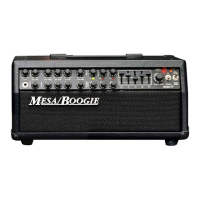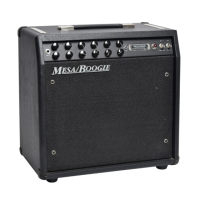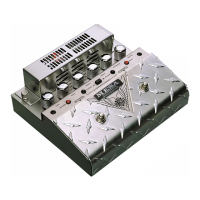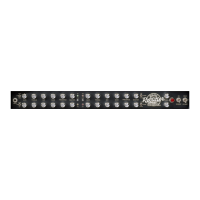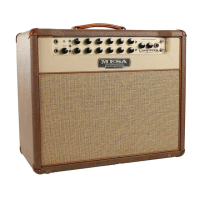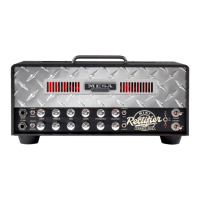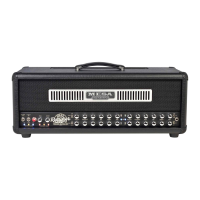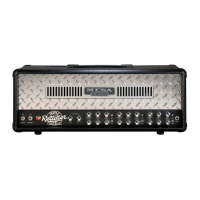GROUND
This switch is often helpful in reducing buzzes which originate in the AC power wiring outside the amplifier. We recommend leaving the
switch in its center OFF position unless position A or B definitely helps. In the center OFF position, your Boogie cannot be the source of
annoying "ground shocks" to the microphones etc.
DIRECT
Previously known as the SLAVE, this feature provides a variable strength signal right from the speaker
jack This way better tone is
supplied, all Effects and Reverb are included, and there is absolutely no loss of the Boogie's tone when running from the Direct to a
mixing board or another amplifier. (Many players will still prefer a microphone "listening" to their speaker coloration.) In some
sophisticated set-ups, players run their Direct into their Effects Rack and then from the Effects into other, external amplifiers. But such a
set-up cannot route the Effects output back into the original Boogie. Also note that a speaker or load resistor should be plugged into a
Speaker jack when using the Direct. Load resistor value...though not critical ... can change the overall tone. Suggested value: 8 ohms,
50 watts minimum. And note that this resistor will get quite hot when running the Boogie "up loud" for long periods.
EFFECTS SEND & RETURN
The Effects Loop circuitry of the Mark III is very sophisticated and works very well with nearly all units. The maximum signal strength
obtainable is around 0.6 volts RMS, or about the same as a guitar pickup. Only the lowest quality, cheap digital delays may experience
some overload and we feel the problem here is caused by poor effect design, which would cost only pennies to remedy. Worst
offenders: Roland SDE 1000, Effectron Jr. Please call Roland or Delta to complain ... not us! Suggest that they "pad their input and
buffer their output", as the real world requires! However, it is possible to further lower the Boogie's Effect output strength but not without
increasing the noise and sacrificing some tone. For those who wish to do this we recommend changing resistor R230 from 6.8K to
4.7K. R230 can be located by following the Black wire from the Send jack back to the circuit board. In the Rhythm modes the Volume 1
control determines the Effects Send level, and in the Lead mode, it is the Lead Master. By running the Master 1 higher and these two
controls lower, you can improve the performance of sub-standard effects.
PRESENCE
This control sets up the basic brightness of the overall tone. But unlike a tone control, the Presence acts on the output and driver
circuits, not the preamp. Season to your liking; recommended setting about 7.
REVERB
Like the Presence, this control is located on the rear panel of short chassis amplifiers ... because there's no more room on the front and
they seldom require adjustment. The Mark III's reverb is by far the best we've ever had; its performance is hard to equal even with
expensive outboard effects. And the Reverb Footswitch also works uniquely: rather than merely switching the Reverb on and off, it
allows you to maintain a good background level then footswitch up to a dramatic, fully drenched reverb for a special effect.
SPEAKERS
One 8-ohm and two 4-ohm jacks are provided. The Boogie is not very sensitive to speaker mismatches and will not be damaged by
them except that very low ohmage loads will cause the power tubes to wear out faster. A single twelve-inch 8-ohm, speaker should
generally be connected to the 8-ohm output on the amp. When using two 8-ohm speakers, connect them both to the 4-ohm outputs
provided (because the total load is 4 ohms in that case).
4x12 cabinets may be 4, 8, or 16 ohms; if you are not sure of the impedance of your cabinet, you may need to remove the rear panel to
see what ohmage the individual speakers are. Most Marshall 4x12 cabinets are 16 ohms. By wiring all four speakers in parallel, you
can reduce the cabinet impedance to 4 ohms (assuming the speakers are 16 ohms each). A MESA/Boogie 4x12 cabinet comes
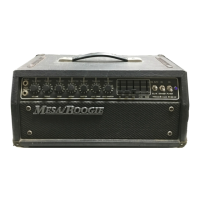
